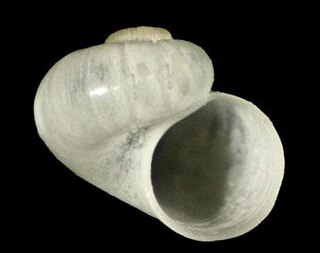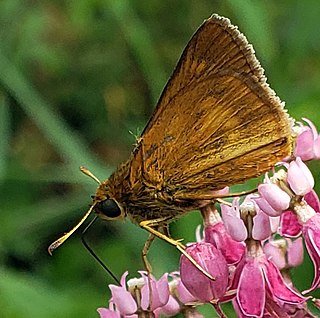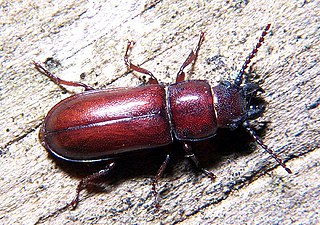
Saxegothaea is a genus comprising a single species, Saxegothaea conspicua. It is a conifer in the podocarp family Podocarpaceae, native to southern South America. It grows in Chile and Argentina from 35° to 46° South latitude; in its northernmost natural distribution it grows between 800 and 1000 (2600–3300 ft) m above sea level and in the south it lives at sea level. The species is most often known by its genus name, or sometimes as female maniu and Prince Albert's yew; in South America it is known as mañío hembra or maniú hembra.

Eurybia conspicua, commonly known as the western showy aster, is a North American species of plants in the family Asteraceae. It is native to western Canada and the western United States.

Akritogyra conspicua is a species of sea snail, a marine gastropod mollusk, unassigned in the superfamily Seguenzioidea.

Euphyes conspicua, the black dash, is a butterfly of the family Hesperiidae. The species was first described by William Henry Edwards in 1863. It is found in the upper Midwest of North America, from eastern Nebraska east to southern Ontario and along the central Atlantic Coast from Massachusetts south to south-eastern Virginia. Its habitat includes shrubby or partially wooded wetland.

Megastomia is a genus of sea snails, marine gastropod mollusks in the family Pyramidellidae, the pyrams and their allies.

Odostomia conspicua is a species of sea snail, a marine gastropod mollusc in the family Pyramidellidae, the pyrams and their allies.

Parandra is a genus of beetles in the family Cerambycidae, containing the following species:

Stenygra is a genus of beetles in the family Cerambycidae, containing the following species:

Stenygra conspicua is a species of beetle in the family Cerambycidae. It was described by Perty in 1832.
Cirrhicera is a genus of longhorn beetles of the subfamily Lamiinae, containing the following species:
Turbinaria conspicua, commonly known as Disc coral, is a species of colonial a stony coral in the family Dendrophylliidae. Found abundant in the eastern Indian Ocean and the western Pacific region, including Indonesia, Papua New Guinea and northern Australia. It is a zooxanthellaa coral that houses symbiont dinoflagellates in its tissues. It was studied by Bernard in 1896 and he rated it as a least concern species by the International Union for Conservation of Nature (IUCN).

Stenoplax conspicua, the conspicuous chiton, is a species of polyplacophoran mollusc belonging to the family Ischnochitonidae.
Cirrhicera championi is a species of beetle in the family Cerambycidae. It was described by Bates in 1881, and it is found in Costa Rica and Mexico.
Cirrhicera cinereola is a species of beetle in the family Cerambycidae. It was described by Bates in 1881. It is known from Mexico and Costa Rica.
Cirrhicera cristipennis is a species of beetle in the family Cerambycidae. It was described by Henry Walter Bates in 1881. It is known from Costa Rica, Mexico, Guatemala and Ecuador.
Cirrhicera panamensis is a species of beetle in the family Cerambycidae. It was described by Bates in 1881. It is known from Costa Rica and Panama.
Cirrhicera leuconota is a species of beetle in the family Cerambycidae. It was described by Laporte in 1840. It is known from Mexico and Honduras.
Cirrhicera nigrina is a species of beetle in the family Cerambycidae. It was described by Thomson in 1857. It is known from Mexico.
Cirrhicera niveosignata is a species of beetle in the family Cerambycidae. It was described by Thomson in 1860. It is known from Mexico.
Odinia conspicua is a species of fly in the family Odiniidae.








